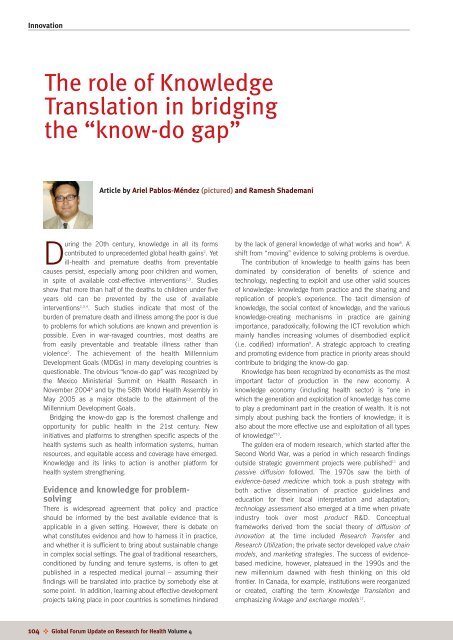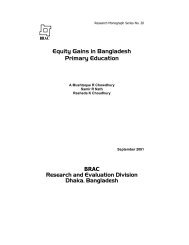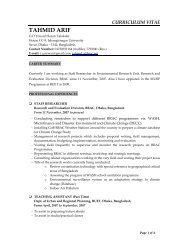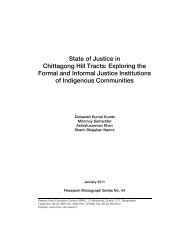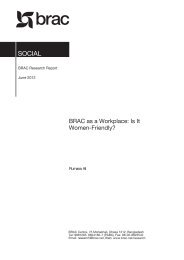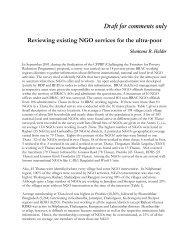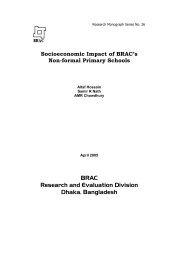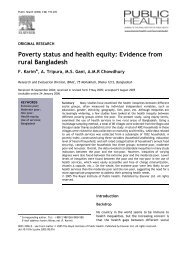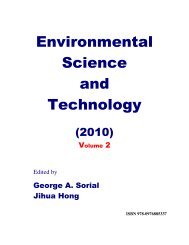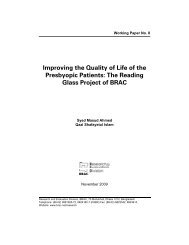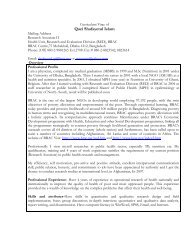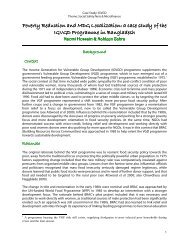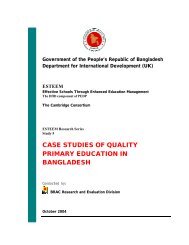Combining health and social protection measures to reach the ultra ...
Combining health and social protection measures to reach the ultra ...
Combining health and social protection measures to reach the ultra ...
You also want an ePaper? Increase the reach of your titles
YUMPU automatically turns print PDFs into web optimized ePapers that Google loves.
Innovation<br />
The role of Knowledge<br />
Translation in bridging<br />
<strong>the</strong> “know-do gap”<br />
Article by Ariel Pablos-Méndez (pictured) <strong>and</strong> Ramesh Shademani<br />
During <strong>the</strong> 20th century, knowledge in all its forms<br />
contributed <strong>to</strong> unprecedented global <strong>health</strong> gains 2 . Yet<br />
ill-<strong>health</strong> <strong>and</strong> premature deaths from preventable<br />
causes persist, especially among poor children <strong>and</strong> women,<br />
in spite of available cost-effective interventions 2,3 . Studies<br />
show that more than half of <strong>the</strong> deaths <strong>to</strong> children under five<br />
years old can be prevented by <strong>the</strong> use of available<br />
interventions 2,3,4 . Such studies indicate that most of <strong>the</strong><br />
burden of premature death <strong>and</strong> illness among <strong>the</strong> poor is due<br />
<strong>to</strong> problems for which solutions are known <strong>and</strong> prevention is<br />
possible. Even in war-ravaged countries, most deaths are<br />
from easily preventable <strong>and</strong> treatable illness ra<strong>the</strong>r than<br />
violence 5 . The achievement of <strong>the</strong> <strong>health</strong> Millennium<br />
Development Goals (MDGs) in many developing countries is<br />
questionable. The obvious “know-do gap” was recognized by<br />
<strong>the</strong> Mexico Ministerial Summit on Health Research in<br />
November 2004 6 <strong>and</strong> by <strong>the</strong> 58th World Health Assembly in<br />
May 2005 as a major obstacle <strong>to</strong> <strong>the</strong> attainment of <strong>the</strong><br />
Millennium Development Goals.<br />
Bridging <strong>the</strong> know-do gap is <strong>the</strong> foremost challenge <strong>and</strong><br />
opportunity for public <strong>health</strong> in <strong>the</strong> 21st century. New<br />
initiatives <strong>and</strong> platforms <strong>to</strong> streng<strong>the</strong>n specific aspects of <strong>the</strong><br />
<strong>health</strong> systems such as <strong>health</strong> information systems, human<br />
resources, <strong>and</strong> equitable access <strong>and</strong> coverage have emerged.<br />
Knowledge <strong>and</strong> its links <strong>to</strong> action is ano<strong>the</strong>r platform for<br />
<strong>health</strong> system streng<strong>the</strong>ning.<br />
Evidence <strong>and</strong> knowledge for problemsolving<br />
There is widespread agreement that policy <strong>and</strong> practice<br />
should be informed by <strong>the</strong> best available evidence that is<br />
applicable in a given setting. However, <strong>the</strong>re is debate on<br />
what constitutes evidence <strong>and</strong> how <strong>to</strong> harness it in practice,<br />
<strong>and</strong> whe<strong>the</strong>r it is sufficient <strong>to</strong> bring about sustainable change<br />
in complex <strong>social</strong> settings. The goal of traditional researchers,<br />
conditioned by funding <strong>and</strong> tenure systems, is often <strong>to</strong> get<br />
published in a respected medical journal – assuming <strong>the</strong>ir<br />
findings will be translated in<strong>to</strong> practice by somebody else at<br />
some point. In addition, learning about effective development<br />
projects taking place in poor countries is sometimes hindered<br />
by <strong>the</strong> lack of general knowledge of what works <strong>and</strong> how 8 . A<br />
shift from “moving” evidence <strong>to</strong> solving problems is overdue.<br />
The contribution of knowledge <strong>to</strong> <strong>health</strong> gains has been<br />
dominated by consideration of benefits of science <strong>and</strong><br />
technology, neglecting <strong>to</strong> exploit <strong>and</strong> use o<strong>the</strong>r valid sources<br />
of knowledge: knowledge from practice <strong>and</strong> <strong>the</strong> sharing <strong>and</strong><br />
replication of people’s experience. The tacit dimension of<br />
knowledge, <strong>the</strong> <strong>social</strong> context of knowledge, <strong>and</strong> <strong>the</strong> various<br />
knowledge-creating mechanisms in practice are gaining<br />
importance, paradoxically, following <strong>the</strong> ICT revolution which<br />
mainly h<strong>and</strong>les increasing volumes of disembodied explicit<br />
(i.e. codified) information 9 . A strategic approach <strong>to</strong> creating<br />
<strong>and</strong> promoting evidence from practice in priority areas should<br />
contribute <strong>to</strong> bridging <strong>the</strong> know-do gap.<br />
Knowledge has been recognized by economists as <strong>the</strong> most<br />
important fac<strong>to</strong>r of production in <strong>the</strong> new economy. A<br />
knowledge economy (including <strong>health</strong> sec<strong>to</strong>r) is “one in<br />
which <strong>the</strong> generation <strong>and</strong> exploitation of knowledge has come<br />
<strong>to</strong> play a predominant part in <strong>the</strong> creation of wealth. It is not<br />
simply about pushing back <strong>the</strong> frontiers of knowledge; it is<br />
also about <strong>the</strong> more effective use <strong>and</strong> exploitation of all types<br />
of knowledge” 10 .<br />
The golden era of modern research, which started after <strong>the</strong><br />
Second World War, was a period in which research findings<br />
outside strategic government projects were published 11 <strong>and</strong><br />
passive diffusion followed. The 1970s saw <strong>the</strong> birth of<br />
evidence-based medicine which <strong>to</strong>ok a push strategy with<br />
both active dissemination of practice guidelines <strong>and</strong><br />
education for <strong>the</strong>ir local interpretation <strong>and</strong> adaptation;<br />
technology assessment also emerged at a time when private<br />
industry <strong>to</strong>ok over most product R&D. Conceptual<br />
frameworks derived from <strong>the</strong> <strong>social</strong> <strong>the</strong>ory of diffusion of<br />
innovation at <strong>the</strong> time included Research Transfer <strong>and</strong><br />
Research Utilization; <strong>the</strong> private sec<strong>to</strong>r developed value chain<br />
models, <strong>and</strong> marketing strategies. The success of evidencebased<br />
medicine, however, plateaued in <strong>the</strong> 1990s <strong>and</strong> <strong>the</strong><br />
new millennium dawned with fresh thinking on this old<br />
frontier. In Canada, for example, institutions were reorganized<br />
or created, crafting <strong>the</strong> term Knowledge Translation <strong>and</strong><br />
emphasizing linkage <strong>and</strong> exchange models 12 .<br />
104 ✜ Global Forum Update on Research for Health Volume 4


